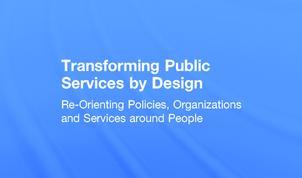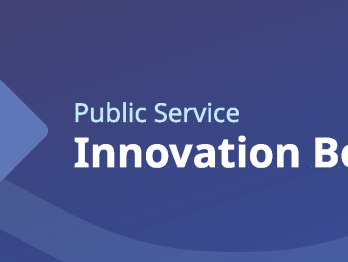Human-Centered Design and Public Sector Innovation

This blog is authored by guest blogger, Sabine Junginger Head, Competence Center for Design and Management at University of Applied Sciences and Arts Lucerne
Public sector challenges inherently concern and involve people. “The Public” after all does not exist in the absence of people. Nor does government. Those we entrust with the responsibilities to govern are people. We ask policy-makers and public managers to develop and implement policies that lead to socially desirable outcomes. In “Transforming Public Services by Design: Re-orienting Policies, Organizations and Services around People” I explain why human-centered design matters to policy-making and policy implementation when the goal is to arrive at citizen-centric policies and citizen-centric public services.
Nowhere are our design practices and our design methods as consequential as in policy-making and in policy implementation. Services – and other products – that result from these design activities often shape the lives of millions of people. It is an area where human-centered design principles and methods can make a major contribution to achieve policy intents that involve public sector innovation and actual social changes.
To illustrate how insights into human experience and human interactions can inform the development of public services and what this implies for designers, public managers and policy-makers, I review three projects from three different time periods.
The Tax Forms Simplification Project by the US Internal Revenue Service recounts a design project from the 1980s that re-envisioned the tax filing experience for individuals around the needs of taxpayers. Here, a government agency was told that its own design capabilities were lacking and ordered to work with external design experts. This project led to the original 1040 EZ tax form most US taxpayers have come to know. But it is also a project marked by misunderstandings about design, designers and design products we still find in play in many of today’s design projects that involve (public and private) services and organisational change.
The second case hones in on the Domestic Mail Manual Transformation Project by the United States Postal Service from the early 2000s. In contrast with the IRS project, the organisation was deeply involved and engaged in a participatory, multi-year design process based on human-centered design principles and methods. The task of redesigning this organisation’s core organisational operation manual into usable, useful and desirable tool tailored to the needs of specific mailers required organisational transformation and changes to the organisation’s culture. The project shows how human-centered design can generate the arguments for the kinds of changes necessary but also develop new paths forwards by creating products and services that provide new opportunities for how the organisation engages and interacts with those it has a mandate to serve. Moreover, this project highlights how deeply embedded services are within an organisation’s structures, how they relate to internal processes and resources as well as to staff.
The Integrated Tax Design Project by the Australian Taxation Office proposes yet another role for human-centered design within a government agency. The aim here was not to reduce design to the development of new tax forms. No single product serves as the entry point for human-centered design to enter the organisation. Instead, the ATO began by acknowledging that the products and services it developed and made available to the Australian taxpayer were often not the kinds of products and services taxpayers needed to fulfill their citizen obligations. This was the start of an inquiry into the agency’s internal design practices and its overall design capabilities that aimed to develop high quality products and services people could use. The approach by the ATO, its systematic introduction of human-centered design, its methods and processes foreshadow public innovation labs like the Govlab in Chile and Mindlab in Denmark.
What matters in today’s quest for new ways of working with change in a systemic way is how human centered design connects people with services, services with organisations, organisations with policy-making and policy-making with policy intent. When policy efforts begin with people, public services become central to policy success. Services are key to successful policies for several reasons:
- People do not experience policies but rather that they experience services attached to a specific policy.
- Services bring policies to life. Without services, policies remain words on paper.
- Services communicate values. If these values differ from those of a given policy, trust in government is at stake.
To take a human-centered design approach to policy-making and policy implementation puts the spotlight on design practices and design processes in the policy cycle.
It means that the design of services that implement and realise a policy are no longer an afterthought. But simply designing or redesigning a service is not enough as the case studies in the book show. Even the best service will fail if the organization responsible for delivering and maintaining it is ill equipped to do so. Re-orienting services around people requires organisations to change, adjust, and sometimes to innovate their own internal ways of going about business. A human-centered approach based on participatory methods invites, engages and enables people within public organisations and in government agencies to explore how their current design principles, design processes and design practices support or hinder that they achieve their objectives: provide the best service possible in the most efficient way to improve the lives of people.
About the author
Sabine Junginger, PhD, heads the Competence Center for Research into Design and Management at Lucerne University of Applied Sciences in Switzerland. She is Research Fellow of the Hertie School of Governance (Germany), an academic advisor to the European Forum Alpbach (Austria) and the UK Design Council (DfE).
She is also the co-editor of Designing Business and Management (Bloomsbury 2016); Highways and Byways to Innovation (University of Southern Denmark/Design School Kolding 2014) and The Handbook of Design Management (Bloomsbury 2011). More information about Transforming Public Services by Design: Re-orienting Policies, Organizations and Services around People can be found here.












